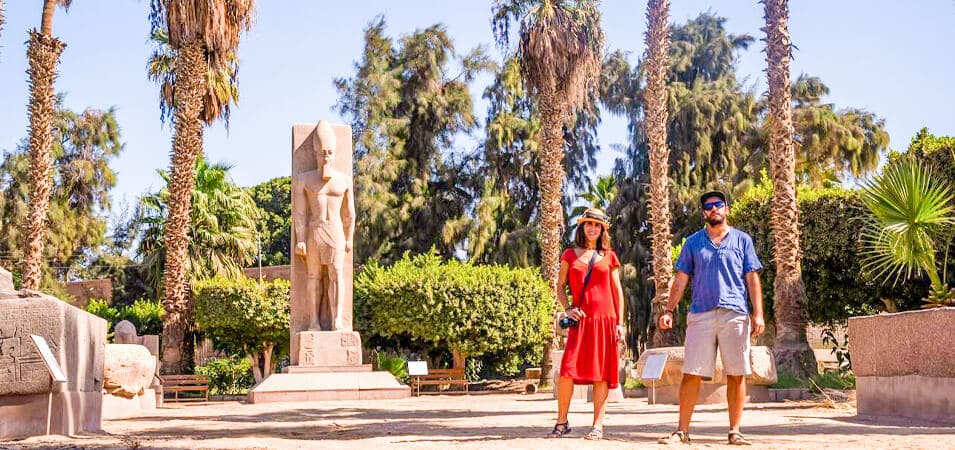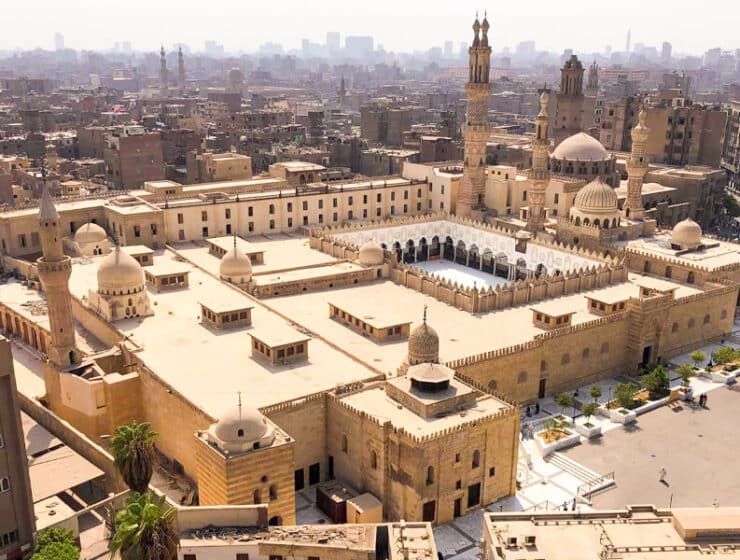Nestled along the banks of the Nile River, the ancient city of Memphis stands as a testament to the grandeur of Egypt’s historical past. This legendary city, often overshadowed by the nearby marvels of the Great Pyramids of Giza, boasts a rich and captivating history that dates back over 4,000 years. As we journey through its storied streets and monumental ruins, we’ll unravel the significance of Memphis as Egypt’s first capital and explore its role in shaping the course of ancient Egyptian civilization. From the grand architecture to the intricate temples and tombs, Memphis continues to whisper tales of a bygone era, offering a captivating window into the enigmatic world of pharaohs and gods. Join us as we delve into the mysteries of Memphis, where history and legend intertwine to create a captivating narrative.
Embark on a self-guided adventure to Explore Cairo on your own terms.
The significance of Memphis as Egypt’s first capital
Memphis, often referred to as “Ineb Hedj,” holds a pivotal place in the annals of Egyptian history as the country’s inaugural capital. Established around 3100 BCE by Pharaoh Menes, its strategic location at the junction of Upper and Lower Egypt symbolized the unification of the two regions into a cohesive nation. This historic city was not merely a political capital but the heart and soul of Egypt’s cultural and religious identity. Memphis was a hub for administrative affairs, trade, and monumental construction projects, including the iconic pyramids at Giza. The city’s significance reverberates through time as it became a center for religious worship and artistic expression, home to the veneration of gods like Ptah and Hathor. By understanding Memphis’ role as Egypt’s inaugural capital, we gain profound insights into the birth of a civilization that would leave an indelible mark on human history.
Shop ’til you drop in the bustling Shopping in Cairo.
Historical background of Memphis

To truly appreciate the magnificence of Memphis, it’s imperative to delve into its rich historical background. This ancient metropolis, founded around 3100 BCE, emerged as the epicenter of Egyptian civilization during the Early Dynastic Period. Memphis played a pivotal role in uniting Upper and Lower Egypt under the rule of Pharaoh Menes, marking the birth of a unified nation. As the capital of Egypt for centuries, Memphis witnessed the rise and fall of numerous dynasties and the ascension of legendary pharaohs like Ramses II. Its sprawling cityscape was adorned with awe-inspiring temples, grand palaces, and monumental statues, reflecting the grandeur of a civilization deeply rooted in art, culture, and spirituality. Over time, Memphis’s prominence waned as political power shifted to other regions. Yet, its legacy endures through its enduring archaeological treasures and profound impact on shaping Egypt’s identity. Exploring the historical background of Memphis is a journey through the annals of time, where the echoes of a bygone era still resonate in the ancient sands of the Nile.
Stroll down the captivating Al-Muizz Street, a vibrant historical thoroughfare.
The architecture and monuments of Memphis
Memphis is a living testament to the ancient Egyptians’ architectural ingenuity and artistic prowess. This sprawling cityscape was once adorned with a stunning array of monumental structures and awe-inspiring monuments showcasing Egyptian architectural achievements’ zenith. Among its most iconic landmarks were the colossal statues of Ramses II, the grand Temple of Ptah, and the Alabaster Sphinx, each a testament to the meticulous craftsmanship of its era. The architectural marvels extended to sprawling palaces, elaborate tombs, and intricate burial complexes that honored the nobility and royalty of the time. Memphis’s architectural legacy is a testament to its builders’ engineering and artistic skills and a window into the spiritual and cultural beliefs that underpin ancient Egyptian society. In this section, we’ll explore the architectural wonders that once graced the streets of Memphis and continue to captivate the world’s imagination.
Experience A Day in the Ancient City of Luxor.
The Great Pyramids of Giza and their connection to Memphis
When we speak of the Great Pyramids of Giza, we cannot separate them from their profound connection to the ancient city of Memphis. Located just a short distance southwest of Memphis, the Giza Plateau houses the world-renowned Khufu, Khafre, and Menkaure pyramids. These colossal structures, among the Seven Wonders of the Ancient World, are a testament to the engineering genius of the ancient Egyptians. This connection is fascinating because Memphis was the administrative and logistical hub for constructing these pyramids.
The limestone quarries, labor camps, and the transportation of massive stone blocks all relied heavily on Memphis’ infrastructure. Additionally, Memphis held significant religious importance, with the Giza pyramids aligned to critical stellar and lunar orientations, underscoring the site’s spiritual significance. As we delve into the connection between Memphis and the Great Pyramids, we gain insights into the monumental undertaking of pyramid construction and the deep-seated spiritual beliefs that drove this architectural marvel.
Temples and tombs in Memphis

Within the ancient city of Memphis, temples and tombs were not merely structures of stone and mortar but repositories of the soul and spirit of a civilization. Memphis was adorned with many temples dedicated to various deities, reflecting the profound religious significance of the city. Among the most notable was the Temple of Ptah, the patron god of craftsmen and artisans, a hub of spiritual devotion and artistic expression.
In contrast, the tombs and burial complexes scattered across Memphis were the final resting places of pharaohs, nobles, and the elite. The Saqqara Necropolis, located on the outskirts of Memphis, is a renowned burial ground featuring the Step Pyramid of Djoser, often considered the precursor to the Giza pyramids.
Memphis unveils the ancient Egyptians’ intricate rituals, beliefs, and artistry, offering a glimpse into their worldview and quest for immortality in the afterlife. These sacred structures remain archaeological treasures, preserving the memories and legacies of those who once walked the streets of Memphis in the shadow of grand temples and within the sanctity of magnificent tombs.
City Of The Dead Cairo, Egypt, a unique and historic Cairo neighborhood.
Art and culture in Memphis
The ancient city of Memphis was a political and religious center and a vibrant hub of art and culture that left an indelible mark on the annals of history. Its streets were lined with grand sculptures, intricately decorated temples, and ornate tombs that served as canvases for artistic expression. Memphis was not just a place of worship but a cultural melting pot where artisans, artisans, and scribes thrived, creating masterpieces that transcend time.
The art of Memphis reflected the Egyptian reverence for the divine, with gods and pharaohs often depicted in intricate detail. Hieroglyphics adorned temple walls, telling stories of myth, history, and daily life. Music, dance, and theater were integral to Memphis’ cultural fabric, with festivals and ceremonies celebrating the changing seasons and religious rites.
To understand Memphis is to immerse oneself in the artistic and cultural tapestry of ancient Egypt, where every stone, every statue, and every symbol told a story of a civilization deeply rooted in its beliefs, values, and creative spirit. Today, Memphis remains a treasure trove for archaeologists, historians, and art enthusiasts, offering a profound glimpse into the artistry and culture that once thrived along the banks of the Nile.
The decline and rediscovery of Memphis
Once the bustling heart of ancient Egypt, Memphis eventually faced a decline that saw its prominence wane. As political power shifted to other regions, particularly Thebes and Alexandria, Memphis gradually faded from its zenith as Egypt’s capital. The city’s decline was compounded by changes in trade routes, invasions, and the erosion of the Nile’s banks.
Over time, Memphis was abandoned, its grandeur forgotten, and its structures buried by the sands of time. The city lay hidden beneath layers of silt and sediment, awaiting rediscovery by
Archaeologists in the modern era.
Rediscovering Memphis was a journey that began in the 19th century with the work of pioneering archaeologists and Egyptologists. Their efforts unearthed the city’s temples, tombs, and monuments, shedding light on its once-thriving civilization. Today, Memphis stands as a testament to the resilience of history, a place where the past was buried and then resurrected, allowing us to connect with the enigmatic world of ancient Egypt and the legacy of a city that once stood proudly along the banks of the Nile.
Gaze upon the enigmatic Great Sphinx of Giza, an eternal mystery.
Visiting Memphis today: attractions and tours.

For modern-day travelers, Memphis offers a captivating journey into the heart of ancient Egypt’s glorious past. The city boasts a range of attractions and tours that allow visitors to explore its historical treasures and immerse themselves in the rich tapestry of its heritage.
Among the must-visit attractions are the Memphis Open-Air Museum, which houses a remarkable collection of colossal statues and artifacts, and the Saqqara Necropolis, where you can marvel at the Step Pyramid of Djoser. The nearby Giza Plateau, with its iconic Great Pyramids and Sphinx, is a short drive away and should be noticed.
Numerous guided tours provide in-depth insights into Memphis and its surroundings. Expert guides can lead you through the sprawling ruins, sharing the stories and mysteries surrounding this ancient city. Boat tours along the Nile offer a unique perspective, showcasing Memphis’s riverside location and its historical significance as a trade hub.
Whether you’re an archaeology enthusiast, a history buff, or simply a curious traveler, Memphis beckons with many attractions and tours that promise an unforgettable journey through time. It’s an opportunity to stand in the footsteps of pharaohs and witness the grandeur of a civilization that continues to inspire and captivate the world.
Explore our Tours:
- Half Day Tour To Memphis And Sakkara
- Day Tour to Giza Pyramids and Memphis and Saqqara
- Day Tour to Giza Pyramids, Memphis, Dahshur and Saqqara
- Day Tour to Memphis and Saqqara and Dahshur
- 3 Day Tour To Cairo
- 3 Days Luxor Tour Package from Cairo
- 4 Day Cairo And Alexandria Tour Package
- 4 Day Cairo Tour Package
- 5 Day Cairo And Alexandria Tour Package
- 5 Day Cairo Tour Package
Visiting Memphis: travel tips and tourist information
Traveling to Memphis, Egypt, to explore its ancient wonders is a rewarding experience, but it’s essential to be well-prepared to make the most of your journey. Here are some travel tips and tourist information to ensure a smooth and enriching visit:
- Entry Requirements: Check visa and entry requirements for Egypt, including passport validity and visa regulations. Ensure your travel documents are in order before departure.
- Best Time to Visit: Memphis can be scorching in the summer months, so consider visiting in the milder spring or fall seasons to enjoy more comfortable weather.
- Currency: The official currency in Egypt is the Egyptian Pound (EGP). ATMs are widely available, and credit cards are accepted at many hotels and larger establishments.
- Local Customs: Familiarize yourself with local customs and etiquette. Dress modestly when visiting religious sites, and ask for permission before taking photos of people.
- Health and Safety: Ensure you have comprehensive travel insurance and consider vaccinations recommended for travelers to Egypt. Drink bottled water and take precautions against the sun and heat.
- Language: Arabic is the official language, but English is widely spoken in tourist areas.
- Guided Tours: Consider booking guided tours to maximize your visit. Knowledgeable guides can provide historical context and insights into the sites you’ll explore.
- Transportation: Cairo International Airport is the nearest major airport. Arrange for transportation to Memphis in advance, and use reputable taxi services or rideshare apps for local travel.
- Accommodation: Choose accommodation in Cairo, as it offers many options. You can take day trips to Memphis from there.
- Respect Heritage: When exploring Memphis and its historical sites, respect the ancient artifacts and structures. Please do not touch or deface them, and follow any posted guidelines.
- Local Cuisine: Take advantage of the opportunity to savor Egyptian cuisine. Try dishes like koshari, falafel, and local sweets.
- Shopping: Memphis and the surrounding areas offer excellent opportunities for shopping, including souvenirs and traditional crafts. Bargaining is expected in local markets.
By keeping these travel tips in mind and respecting Memphis’s cultural and historical significance, you can enjoy a rewarding and enlightening visit to this ancient city and its archaeological wonders.
Conclusion
The ancient city of Memphis is an enduring testament to the grandeur and significance of Egypt’s past. As we’ve explored in this blog, Memphis was not merely a city but a crucible of civilization where history, art, culture, and spirituality converged. From its foundational role as Egypt’s first capital to its decline and subsequent rediscovery, Memphis has offered us a window into the depths of antiquity.
Its architectural marvels, temples, and tombs speak of a people deeply connected to their gods and the afterlife, while its art and culture continue to captivate the imagination. Today, Memphis invites travelers to embark on a journey through time, to walk in the footsteps of pharaohs, and to stand before the awe-inspiring pyramids that guard its legacy.
With a wealth of attractions, guided tours, and cultural experiences, visiting Memphis is an opportunity to connect with a bygone era and gain a profound appreciation for the remarkable civilization that flourished along the banks of the Nile. As we bid farewell to this ancient city, we are reminded that the echoes of its history still reverberate, beckoning us to explore, learn, and be inspired by the marvels of Memphis.





